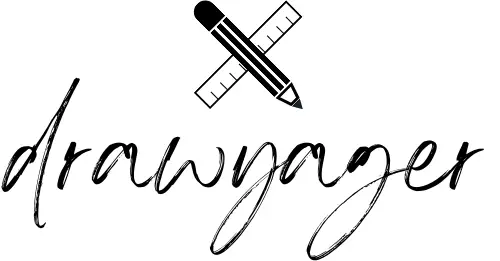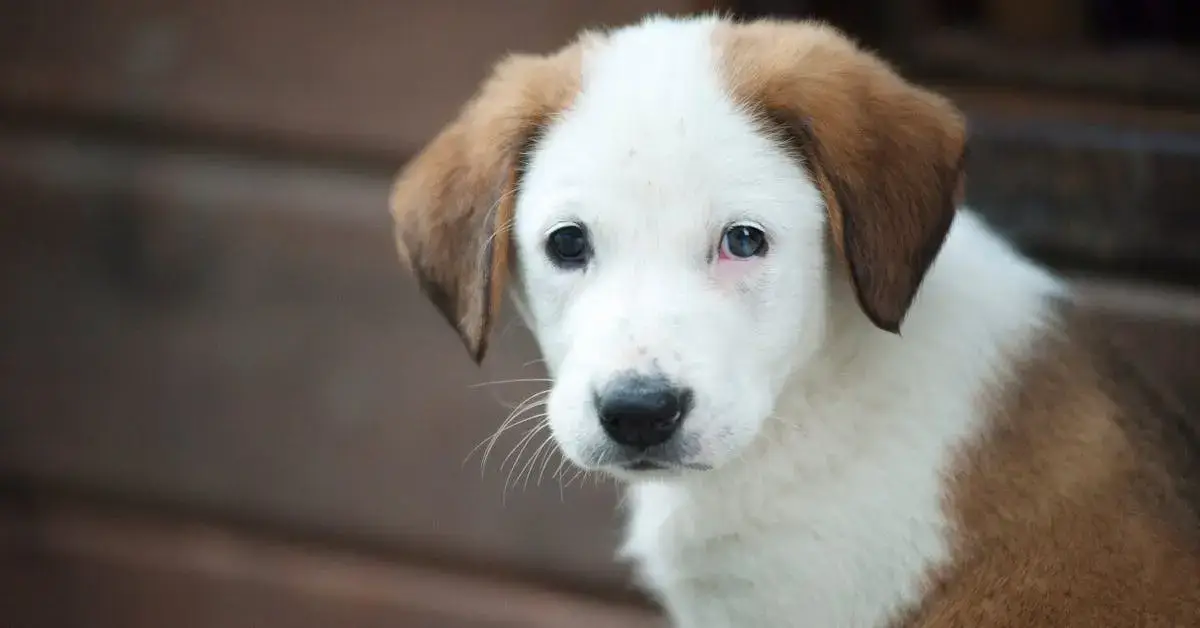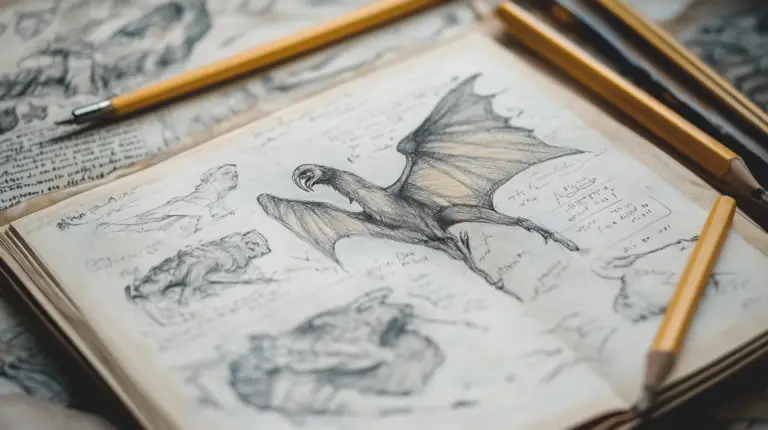Looking to improve your drawing skills with some fun dog drawing ideas? Then you’ve come to the right place! Sketching different dog breeds, from tiny chihuahuas to massive retrievers, is one of my favorite activities. Even if you’re a beginner, you can easily follow these tips and tricks to create cute and simple dog characters.
One of the best parts about exploring dog drawing ideas is capturing their unique personalities and poses. Whether you want to draw a playful puppy or a majestic guard dog, there are countless styles to explore. For those just starting out, using simple shapes and lines can make the process much less daunting.

I also find it helpful to look at various tutorials to get inspiration and guidance. Websites like Easy Drawing Guides offer step-by-step instructions that make learning fun and accessible. Continue reading for a lot of Dog Drawing Ideas.
Simple Dog Designs for Beginners
Step-by-Step To Bring Your Dog Drawing Ideas To Life
You can follow this Step-by-Step Tutorial to create your own first Dog Drawing!
Rough Body Shape
Begin by sketching a large oval for the body and a smaller circle for the head. Lightly draw these shapes to serve as a guide.
Guidelines
Draw a vertical line down the center of the head circle and a horizontal line across it. These will help you place the facial features symmetrically.
Details on the head
Add two triangles or oval shapes on top of the head for the ears. Adjust the size and shape according to the breed you are drawing.
Adding the Snout
Draw a smaller oval or rectangle extending from the bottom of the head circle to form the snout. Add a small circle at the end for the nose.
Drawing the eyes
Place the eyes on the horizontal guideline within the head circle. Draw two ovals or circles, leaving a small white spot in each to represent the reflection of light.
Adding the Mouth
Sketch a small line or curved shape under the nose to create the mouth. Add a slight curve for the lower lip if desired.
Refine the Body Shape
Refine the shape of the body by drawing a smooth, curved line connecting the head to the body oval. Add a slight dip at the shoulders and hips.
Adding Legs
Draw four legs extending from the body. Use simple lines and basic shapes like rectangles or cylinders to outline the legs and paws.
Tail shouldn’t be missing
Add the tail by drawing a curved line extending from the rear of the body. Adjust the length and shape based on the breed you are drawing.
Erase and finish
Erase any unnecessary guidelines and refine the drawing. Add details like fur texture, markings, and shading to give your dog more depth and realism.

Incorporating Simple Dog Poses
- Sitting: A basic pose with the dog sitting upright on its hind legs, front legs straight and head facing forward.
- Standing: The dog stands on all fours, with its body straight and head facing forward or slightly to the side.
- Lying Down: The dog lies on its belly with its legs stretched out in front or to the side, head resting on its paws.
- Play Bow: The dog lowers its front half to the ground with its hindquarters raised, tail wagging.
- Running: Capture the dog mid-stride with legs extended forward and backward, body slightly arched.
- Sleeping: The dog is curled up in a ball, with its head tucked close to its body or stretched out.
- Begging: The dog sits on its hind legs with its front paws raised and bent, looking up.
- Head Tilt: The dog sits or stands with its head tilted to one side, ears perked up.
- Rolling Over: The dog lies on its back with legs in the air, slightly twisted to one side.
- Leaping: The dog is captured mid-leap, with all four legs off the ground and body stretched out.

50 Dog Drawing Ideas
- Puppy in a Teacup: Illustrate an adorable puppy sitting inside a delicate teacup with a playful expression.
- Dog and Owner Selfie: Draw a girl taking a selfie with her dog, both making funny faces at the camera.
- Dog with Flower Crown: Depict a dog wearing a beautiful flower crown made of colorful blooms.
- Puppy Paw Prints: Create an image of a trail of puppy paw prints leading to a sleeping pup.
- Dog Under an Umbrella: Illustrate a dog sitting under a bright umbrella on a rainy day, splashing in puddles.
- Dogs in Space: Draw a dog astronaut floating in space, perhaps chasing a bone-shaped planet.
- Beach Day with Dog: Depict a dog playing on the beach, fetching a frisbee or digging in the sand.
- Dog with Balloon Bundle: Illustrate a dog being lifted slightly off the ground by a bunch of colorful balloons tied to its collar.
- Dog Reading a Book: Draw a dog with glasses, sitting in a cozy chair reading a book.
- Puppy Dreams: Depict a sleeping puppy surrounded by dream bubbles showing playful scenes.
- Dog and Butterfly: Illustrate a dog curiously watching a butterfly perched on its nose.
- Dog Yoga Pose: Draw a dog mimicking a yoga pose alongside its owner on yoga mats.
- Dog in a Flower Field: Depict a dog joyfully running through a field of wildflowers.
- Dog Café Scene: Illustrate a dog sitting at an outdoor café table, perhaps with a coffee cup.
- Balloon Dog Parade: Draw dogs shaped like balloon animals in a whimsical parade.
- Dog in Rain Boots: Depict a dog wearing cute rain boots, splashing through puddles.
- Puppy Kisses: Illustrate a girl receiving affectionate licks from her puppy.
- Dog and Snowman: Draw a dog playfully interacting with a snowman in a winter scene.
- Dog with Sunglasses: Depict a cool dog wearing sunglasses, perhaps riding in a car with the wind in its fur.
- Dog and Moonlight: Illustrate a dog howling softly at a full moon in a serene night setting.
- Puppy Pile: Draw a pile of sleeping puppies cuddled together.
- Dog at a Picnic: Depict a dog enjoying a picnic with a spread of treats and a checkered blanket.
- Doggy Fashion Show: Illustrate a series of dogs dressed in fashionable outfits strutting down a runway.
- Dog and Balloons: Draw a dog chasing after floating balloons in a park.
- Dog Friendship Circle: Depict a group of dogs of different breeds sitting in a circle, showcasing diversity and friendship.
- Dog in Autumn Leaves: Illustrate a dog jumping into a pile of colorful autumn leaves.
- Puppy with Teddy Bear: Draw a puppy cuddling with a soft teddy bear.
- Dog Watching Sunset: Depict a dog sitting on a hill watching a beautiful sunset.
- Dog and Bubbles: Illustrate a dog playfully popping soap bubbles with its nose and paws.
- Dog’s Birthday Party: Draw a dog celebrating its birthday with a cake and party hats.
- Dog in Flower Garden: Depict a dog sniffing flowers in a lush garden.
- Dog on a Swing: Illustrate a dog sitting on a swing in a playground.
- Dog and Rainbow: Draw a dog standing at the end of a rainbow, symbolizing joy and hope.
- Dog with Giant Bone: Depict a happy dog proudly holding comically oversized bone.
- Doggy Road Trip: Illustrate a dog leaning out of a car window, ears flapping in the wind.
- Dog in a Hammock: Draw a dog lounging in a hammock between two trees.
- Puppy Learning to Howl: Depict a young puppy attempting to howl, with a sweet expression.
- Dog and Paintbrush: Illustrate a dog holding a paintbrush, having created a paw print masterpiece.
- Dog and Kitten Friendship: Draw a dog gently interacting with a tiny kitten.
- Dog with Heart Balloons: Depict a dog holding heart-shaped balloons, perfect for a romantic theme.
- Dog at the Movies: Illustrate a dog sitting in a movie theater seat, popcorn in paw.
- Dog Under a Blanket Fort: Draw a cozy scene of a dog under a blanket fort with fairy lights.
- Dog on a Cloud: Depict a whimsical scene of a dog resting on a fluffy cloud in the sky.
- Dog in a Field of Dandelions: Illustrate a dog surrounded by dandelions, some floating away as the dog plays.
- Dog Chef Baking Cookies: Draw a dog wearing a chef’s hat, baking bone-shaped cookies.
- Dog and Mirror Reflection: Depict a dog curiously looking at its reflection in a mirror.
- Dog’s First Snow: Illustrate a puppy experiencing snow for the first time, pawing at snowflakes.
- Dog with a Mailbox: Draw a dog bringing mail from a mailbox, perhaps a love letter.
- Dog and Dream Catcher: Depict a dog sleeping under a dream catcher, symbolizing sweet dreams.
- Dog and City Skyline: Illustrate a dog sitting on a rooftop overlooking a city skyline at night.
Drawing Different Dog Breeds
When drawing different dog breeds, it’s essential to capture their unique characteristics and personalities. I’ll highlight the charm of drawing puppies and the distinctive traits of popular breeds to help you bring each dog drawing ideas to life in your artwork.

The Charm of Drawing Puppies
Drawing puppies is an absolute delight because their features are soft and exaggerated. Their large, round eyes, floppy ears, and tiny paws make them irresistibly cute.

A cartoon puppy with big, expressive eyes and a wagging tail can instantly bring joy to a drawing. For example, depicting a cute puppy dog sitting patiently can evoke warmth and happiness.

When sketching puppies, focus on the softness of their fur and the roundness of their features. Keep the strokes light and delicate to reflect their youthful innocence. Whether it’s a playful puppy or a calm, sleeping one, the detail lies in their youthful energy and sweet expressions. And also they are so cute and are always a great addition to you dog drawing ideas.
Popular Breeds and Their Traits
- Labrador Retriever: Friendly, outgoing, high energy; loves to swim and retrieve.
- German Shepherd: Intelligent, loyal, protective; excels in work and obedience.
- Golden Retriever: Friendly, tolerant, intelligent; great family pet and excellent at retrieving.
- French Bulldog: Affectionate, playful, adaptable; known for their distinctive “bat ears.”
- Beagle: Curious, friendly, merry; an excellent sense of smell and tracking instincts.
- Poodle: Intelligent, active, elegant; comes in three sizes (standard, miniature, toy).
- Bulldog: Docile, willful, friendly; known for their distinctive wrinkled face and pushed-in nose.
- Yorkshire Terrier: Bold, confident, feisty; small in size but big in personality.
- Rottweiler: Confident, fearless, good-natured; strong and robust with a protective nature.

- Dachshund: Curious, brave, lively; long body with short legs, known as “wiener dogs.”
- Boxer: Energetic, playful, loyal; muscular build with a distinctive square jaw.
- Siberian Husky: Outgoing, friendly, energetic; known for their striking eyes and endurance.
- Chihuahua: Charming, graceful, sassy; very small size with a big personality.
- Doberman Pinscher: Fearless, loyal, intelligent; sleek and powerful build, excellent guard dog.
- Shih Tzu: Affectionate, playful, outgoing; known for their luxurious, long coat.
- Pomeranian: Lively, bold, inquisitive; small size with a fluffy coat and a fox-like expression.
- Border Collie: Intelligent, energetic, hardworking; excels in herding and agility.
- Cocker Spaniel: Gentle, affectionate, lively; known for their long, flowing ears and soft coat.
- Australian Shepherd: Intelligent, energetic, hardworking; excels in herding and agility.
- Saint Bernard: Gentle, friendly, patient; very large size, known for their rescue work in the Alps.
Creating Cartoons and Stylized Dog Art
Cartoon Dog Drawing Ideas Tutorial
When drawing cartoon dogs, I start with basic shapes. For the head, I might use a circle or oval. This gives me a foundation to build upon. The body often begins as a simple rectangle or egg shape. Don’t forget the limbs; they are usually cylindrical shapes for easy adjustment.

Next, I focus on facial features. Big, round eyes can make the dog look adorable. Placing concentric circles inside the eyes, as suggested in this guide, adds depth and expression. The nose is usually a small oval, and the mouth can be a simple curved line.
Ears should match the dog’s breed or style. Floppy ears for a cute puppy or pointy ones for a husky. Finally, add details like a wagging tail, and extra touches like a dog paw print or a collar for personality. Use a clean outline to finish your drawing.

Stylizing Your Dog Drawing Ideas
- Head Shape: Start by drawing a large circle for the head. This will be the foundation of your cartoon dog’s head.
- Guidelines: Draw a vertical and horizontal line intersecting in the middle of the head circle. These will help you place the facial features symmetrically.
- Ears: Add two floppy ears on top of the head circle. Use simple curved lines to create the ears, making sure they are proportionate to the head.
- Snout: Draw an oval or rounded rectangle extending from the bottom of the head circle for the snout. Add a small oval at the end for the nose.
- Eyes: Place two large, round eyes above the snout on the horizontal guideline. Add small circles inside the eyes for the pupils, leaving a tiny white spot to represent the reflection of light.
- Mouth: Draw a curved line under the snout for the mouth. You can make it simple with a small smile or add a tongue sticking out for a playful look.
- Body Shape: Draw a large oval or pear shape under the head for the body. Make sure it is slightly tilted to give a more dynamic pose.
- Legs: Sketch four legs extending from the body. Use simple lines and ovals to outline the legs and add small ovals at the ends for the paws.
- Tail: Add a curved line extending from the rear of the body for the tail. You can make it straight, curly, or fluffy depending on the type of cartoon dog you want.
- Details and Refinement: Erase any unnecessary guidelines and refine your drawing. Add details like fur texture, spots, or a collar to give your cartoon dog more character. You can also add shading to give it depth and dimension.

Detailed Dog Drawing Ideas
If you want to master drawing a dog’s detail, you need a lot of practice. But the good news is, that you can focus on different parts when drawing dogs. Focusing on specific features like the eyes, nose, snout, ears, and tail is key to capturing accurate and lifelike representations.
Mastering the Dog’s Eyes
Mastering the dog’s eyes is crucial for bringing your canine drawings to life. Start by observing the unique shape and placement of the eyes, which can vary significantly between breeds. Focus on the reflection of light within the eyes to create a lifelike sparkle.

Pay attention to the details of the iris and pupil, capturing the subtle color variations and depth. Use delicate shading around the eyes to emphasize their roundness and the surrounding fur texture. The eyes are the key to conveying the dog’s emotions and personality, so take your time to perfect this essential feature in your dog drawing ideas.
Drawing the Nose and Snout
Drawing the nose and snout of a dog adds essential character to your sketch. Begin with the nose, focusing on its shape and texture – whether it’s broad, narrow, wet, or shiny.
Use subtle shading to highlight the nostrils and the unique surface of the nose. For the snout, consider the breed-specific length and structure, ensuring accurate proportions.

Add fine lines to depict the fur around the snout and use gentle gradients to create a sense of depth. Capturing the nuances of the nose and snout is vital for realistic and expressive dog drawing ideas.
Capturing the Dog’s Ears
Ears come in various shapes and sizes, from floppy and relaxed to erect and alert. Start by studying the specific ear type of the breed you are drawing.
Use light, flowing lines to outline the basic shape, and then add details such as the inner ear structure and the fur’s texture. Pay attention to how the ears attach to the head and their natural positioning. Shading can add depth and dimension, making the ears look more realistic.

Mastering the details of the ears can significantly enhance your dog drawing ideas, giving your artwork a lifelike and expressive quality.
Perfecting the Dog’s Tail
Perfecting the dog’s tail is essential for adding balance and personality to your drawing. Tails come in many shapes and styles, from bushy and curled to sleek and straight.
Begin by understanding the breed-specific tail characteristics and the natural way it flows or curls. Use smooth, confident lines to outline the tail’s shape, paying attention to its length and thickness. Add texture by sketching the fur, using varying strokes to represent short, smooth hair or long, fluffy fur.

Shading can add depth and realism, showing how the tail moves and catches the light. Capturing the unique qualities of the tail completes your dog drawing ideas, making your artwork both accurate and dynamic.
Drawing Dogs for Kids and Educational Purposes
Drawing dogs can be an exciting and educational activity for kids. Not only does it aid in developing their artistic skills, but it also offers numerous learning benefits.
Easy and Fun Dog Drawing Ideas for Children
- Happy Puppy: Draw a cheerful puppy with big, bright eyes and a wide smile.
- Sleeping Dog: Draw a dog curled up and sleeping, with closed eyes and relaxed ears.
- Dog with a Ball: Draw a dog playing with a ball or holding it in its mouth.
- Superhero Dog: Draw a dog with a cape and mask, like a superhero.
- Dog with a Bone: Draw a dog chewing on a bone or proudly holding a bone in its mouth.
- Dog in a Doghouse: Draw a dog sitting in or in front of a cute doghouse.
- Flying Dog: Draw a dog flying through the air like a superhero, maybe with a funny hat or goggles.
- Dog at the Beach: Draw a dog playing at the beach, wearing sunglasses and maybe with a beach ball.
- Dog and Butterfly: Draw a dog curiously watching a butterfly floating nearby.
- Party Dog: Draw a dog wearing a party hat, surrounded by balloons and confetti.
Also you can combine it with Landscape Drawing Ideas: Tips and Inspiration for Beginners 2024 or Spring Drawing Ideas: Unleash Your Creativity with Seasonal Inspiration 2024 to let children create wonderful drawings.
Educational Aspects of Bringing Dog Drawing Ideas to Life
Drawing dogs offers numerous educational benefits for children, enhancing both their artistic skills and overall development. One significant aspect is the understanding of anatomy, as learning to draw dogs helps children grasp the basic structure of bones, muscles, and proportions in animals. This activity also sharpens their observation skills, requiring them to pay close attention to details like fur texture, eye shape, and body posture.
Moreover, drawing dogs stimulates creativity and imagination, allowing children to create unique dog characters and scenes. This creative process improves fine motor skills and hand-eye coordination through detailed drawing and shading techniques. Additionally, children learn various artistic techniques such as shading, perspective, and proportion, which are essential for all forms of drawing.
The act of drawing intricate dog features fosters patience and concentration, helping to develop these crucial skills. By exploring different dog breeds, children can also gain cultural awareness, learning about the histories and traditions associated with each breed.
Drawing dogs serves as an emotional outlet, enabling children to express their feelings and emotions through their artwork, whether depicting a joyful or a melancholic dog. It also encourages storytelling, as children create backgrounds and narratives for their drawings, enhancing their language and communication abilities.
Lastly, drawing dogs enhances problem-solving skills, as children learn to translate three-dimensional shapes into two-dimensional drawings and tackle various artistic challenges.
Overall, drawing dogs is a multifaceted educational activity that supports children’s growth in numerous ways.
What are some easy steps to start drawing a dog?
Begin by sketching basic shapes like circles and ovals to outline the body, head, and limbs. This establishes a strong foundation. Next, refine the shapes by adding details, such as the eyes, nose, and ears. Finish with shading and textures to give the dog more dimension and realism.
Can you suggest some cute dog drawing concepts for beginners?
Try drawing cartoon-style dogs or focusing on specific breeds known for their cuteness, like pugs or corgis. Puppies are also great subjects since their features are often exaggerated and easier to capture. Experiment with different poses, such as a dog sitting or lying down with playful expressions.
Where can I find inspiration for realistic dog drawings?
Realistic dog drawings can be inspired by photos of your own pet, visits to a dog park, or browsing dog images online. Websites offering step-by-step guides and tutorials provide structured learning and inspiration. Observing various breeds in real-life settings also offers great insights into their unique features.
What are the best techniques for drawing a dog with pencils?
Use a range of pencils from HB to 4B to capture both fine details and deep shadows. Start with light, loose sketches and gradually darken areas to build up texture and contrast. Adding shading to emphasize fur and muscle structure will create a more lifelike appearance. Keep an eraser handy for refining and correcting lines.
How can children learn to draw dogs simply and enjoyably?
Children can start with easy-to-follow drawing tutorials that break down the process into simple steps. Using coloring books with dog illustrations or drawing from photos of their favorite dog breeds can make the activity more engaging. Encourage creativity and praise their efforts to keep it fun.
What are some tips for adding colour to a dog drawing?
Begin with light colors and gradually layer darker shades to add depth. Colored pencils or markers work well for this. Pay attention to the direction of the fur when adding color to achieve a more natural look. Experiment with blending techniques to create smooth transitions between colors, enhancing the drawing’s overall realism.
If you liked this blog post about Dog Drawing IDeas, don’t forget to leave me a comment down below to tell me about your experience with it.







I am so excited to start drawing some of these ideas! Thank you so much for the tips and suggestions! I enjoy drawing but I am not great at it. So I am grateful for the help!
I’m glad I could inspire you!
Enjoying drawing is one of the most important things – and who’s the judge of who’s great and who’s not, as long as you’re having fun?